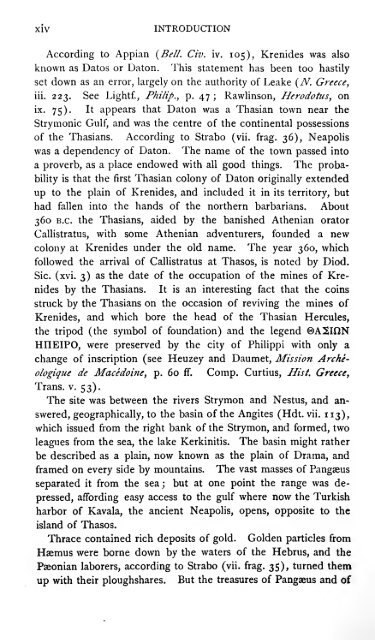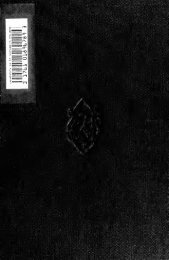Philippians and Philemon - MR Vincent - 1906.pdf
Philippians and Philemon - MR Vincent - 1906.pdf
Philippians and Philemon - MR Vincent - 1906.pdf
You also want an ePaper? Increase the reach of your titles
YUMPU automatically turns print PDFs into web optimized ePapers that Google loves.
xiv INTRODUCTION<br />
According to Appian {Bell. Civ. iv. 105), Krenides was also<br />
known as Datos or Daton. This statement has been too hastily<br />
set down as an error, largely on the authority of Leake (iV. Greece,<br />
iii. 223. See Lightf., Philip., p. 47 ; Rawlinson, Herodotus, on<br />
ix. 75). It appears that Daton was a Thasian town near the<br />
Strymonic Gulf, <strong>and</strong> was the centre of the continental possessions<br />
of the Thasians. According to Strabo (vii. frag. 36), Neapolis<br />
was a dependency of Daton. The name of the town passed into<br />
a proverb, as a place endowed with all good things. The proba-<br />
bility is that the first Thasian colony of Daton originally extended<br />
up to the plain of Krenides, <strong>and</strong> included it in its territory, but<br />
had fallen into the h<strong>and</strong>s of the northern barbarians. About<br />
360 B.C. the Thasians, aided by the banished Athenian orator<br />
Callistratus, with some Athenian adventurers, founded a new<br />
colony at Krenides under the old name. The year 360, which<br />
followed the arrival of Callistratus at Thasos, is noted by Diod.<br />
Sic. (xvi. 3) as the date of the occupation of the mines of Krenides<br />
by the Thasians. It is an interesting fact that the coins<br />
struck by the Thasians on the occasion of reviving the mines of<br />
Krenides, <strong>and</strong> which bore the head of the Thasian Hercules,<br />
the tripod (the symbol of foundation) <strong>and</strong> the legend2<br />
,were preserved by the city of Philippi with only a<br />
change of inscription (see Heuzey <strong>and</strong> Daumet, Mission Arche-<br />
ologique de Macedoine, p. 60 ff. Comp. Curtius, Hist. Greece,<br />
Trans, v. 53).<br />
The site was between the rivers Strymon <strong>and</strong> Nestus, <strong>and</strong> an-<br />
swered, geographically, to the basin of the Angites (Hdt. vii. 113),<br />
which issued from the right bank of the Strymon, <strong>and</strong> formed, two<br />
leagues from the sea, the lake Kerkinitis. The basin might rather<br />
be described as a plain, now known as the plain of Drama, <strong>and</strong><br />
framed on every side by mountains. The vast masses of Pangseus<br />
separated it from the sea; but at one point the range was de-<br />
pressed, affording easy access to the gulf where now the Turkish<br />
harbor of Kavala, the ancient Neapolis, opens, opposite to the<br />
isl<strong>and</strong> of Thasos.<br />
Thrace contained rich deposits of gold. Golden particles from<br />
Haemus were borne down by the waters of the Hebrus, <strong>and</strong> the<br />
Pgeonian laborers, according to Strabo (vii. frag. 35), turned them<br />
up with their ploughshares. But the treasures of Pangseus <strong>and</strong> of





